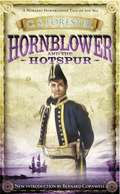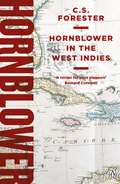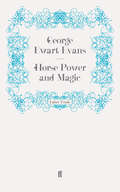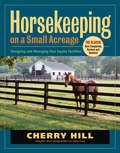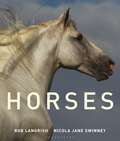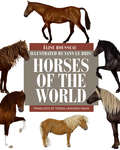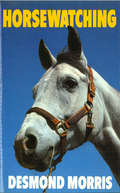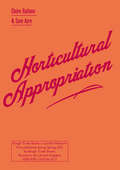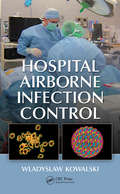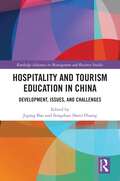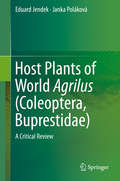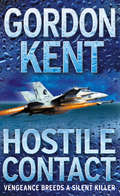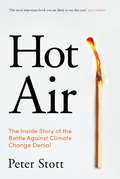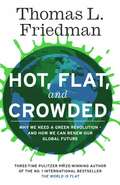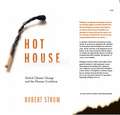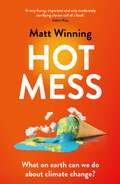- Table View
- List View
Hornblower and the Hotspur (A Horatio Hornblower Tale of the Sea #3)
by C.S. ForesterThe Third Horatio Hornblower Tale of the SeaApril 1803, and the Peace of Amiens is failing as Horatio Hornblower takes a sloop on a vital reconnaissance mission . . .On the day of his marriage to Maria, Hornblower is ordered to take the Hotspur and head for Brest - war is coming and Napoleon will not catch His Majesty's navy with its britches round its ankles. With thoughts of his new life as a husband intruding on his duties, Hornblower must prove himself to be not only the most capable commander in the fleet, but also its most daring if he is to stop the French gaining the upper hand.This is the third of eleven books chronicling the adventures of C. S. Forester's inimitable nautical hero, Horatio Hornblower.Featuring an exclusive introduction by Bernard Cornwell, creator of Sharpe'A master of the genre' New York Times Book Review
Hornblower in the West Indies: St. Elizabeth Of Hungary; The Star Of The South; The Bewildered Pirates (A Horatio Hornblower Tale of the Sea #11)
by C. S. Forester1815, the Napoleonic Wars are over. Yet peace continues to elude Horatio Hornblower overseas … As an admiral struggling to impose order in the chaotic aftermath of the French wars, Horatio Hornblower, Commander-in-chief of His Majesty’s ships and vessels in the West Indies, must still face savage pirates, reckless revolutionaries and a violent hurricane. And while his retirement at half-pay might well be in sight, Hornblower will need every ounce of his rapier wit and quick thinking – not to mention his courage and leadership – to ensure that the lasting peace in Europe reaches the turbulent seas of the West Indies. This is the tenth of eleven books chronicling the adventures of C. S. Forester’s inimitable nautical hero, Horatio Hornblower.
Horse Breeds of North America: The Pocket Guide to 96 Essential Breeds
by Judith DutsonAn amazing variety of horse breeds roam North America&’s vast and geographically diverse landscape. This detailed portable handbook celebrates the unique qualities of 96 regional breeds, from the sleek muscles of racing thoroughbreds and the stoic power of draft horses to the easy gait of pleasure horses at your local farm. Fascinating facts about each horse breed&’s size, talents, and suitability for various types of work are accompanied by full-color photographs in this fun and informative reference guide.
Horse Chestnut tree (Large Print)
by Rnib BookshareIn this image of a horse chestnut tree, the trunk stems from the bottom centre of the page and the leafy branches are in the middle of the page. There is a locator dot shown, which will be at the top left of the page when the image is the right way up. There is a picture of a horse chestnut leaf in the top left and a picture of a horse chestnut in the top right of the page. The leaf stem is to the top right of the leaf itself. The nut is similarly positioned. For scale there is a 'stick man' representing the height of an adult person in the bottom right of the page. The horse chestnut was introduced to Britain 400 years ago. It is now a common sight and noticeable as it is often the first deciduous tree to leaf in the spring and the first to colour in autumn. Its inedible nuts housed in spiky husks are used as conkers in the well-known game. It is not especially long-lived, rapidly decaying and collapsing after a hundred or so years.
Horse Chestnut tree (UEB Contracted)
by Rnib BookshareIn this image of a horse chestnut tree, the trunk stems from the bottom centre of the page and the leafy branches are in the middle of the page. There is a locator dot shown, which will be at the top left of the page when the image is the right way up. There is a picture of a horse chestnut leaf in the top left and a picture of a horse chestnut in the top right of the page. The leaf stem is to the top right of the leaf itself. The nut is similarly positioned. For scale there is a 'stick man' representing the height of an adult person in the bottom right of the page. The horse chestnut was introduced to Britain 400 years ago. It is now a common sight and noticeable as it is often the first deciduous tree to leaf in the spring and the first to colour in autumn. Its inedible nuts housed in spiky husks are used as conkers in the well-known game. It is not especially long-lived, rapidly decaying and collapsing after a hundred or so years.
Horse Chestnut tree (UEB Uncontracted)
by Rnib BookshareIn this image of a horse chestnut tree, the trunk stems from the bottom centre of the page and the leafy branches are in the middle of the page. There is a locator dot shown, which will be at the top left of the page when the image is the right way up. There is a picture of a horse chestnut leaf in the top left and a picture of a horse chestnut in the top right of the page. The leaf stem is to the top right of the leaf itself. The nut is similarly positioned. For scale there is a 'stick man' representing the height of an adult person in the bottom right of the page. The horse chestnut was introduced to Britain 400 years ago. It is now a common sight and noticeable as it is often the first deciduous tree to leaf in the spring and the first to colour in autumn. Its inedible nuts housed in spiky husks are used as conkers in the well-known game. It is not especially long-lived, rapidly decaying and collapsing after a hundred or so years.
Horse Power and Magic
by George Ewart EvansThe pioneering oral historian, George Ewart Evans, began to record the farming ways of East Anglia in the 1950s by listening to old men and women whose memories went back more than fifty or sixty years. Many were agricultural labourers, born before the turn of the century, who had worked on farms before the arrival of mechanisation. It was assumed at that time that horses would soon disappear from the farms, and that this was the last chance of recording the part they had played for centuries. It later became clear that this forecast was too pessimistic and in Horse Power and Magic (Faber, 1979) Ewart Evans describes in fascinating detail some important farms where horses continued to be beneficially used more than thirty years later. He discovered that the traditions of the older horsemen had not died out but had been passed on, in only slightly attenuated form, to a younger generation keen to farm with horses, proving that the day of the heavy horse was by no means over. He also describes vividly the ways of horse-tamers whose skills had a touch of 'magic' about them.'Taking his works a whole, there is no doubt that George Ewart Evans will survive as a fascinating pioneer of the extra-academic recording of human history...he has found a dimension all his own. This is indeed the very stuff of history.' Sunday Times
Horsekeeping on a Small Acreage: Designing and Managing Your Equine Facilities
by Cherry HillKeeping your own horses requires dedication, hard work, and a sincere interest in the well-being of your animals. This practical guide shows you how to design efficient facilities and establish effective maintenance routines so that your horses can stay happy, healthy, and safe on even the smallest plots of land. Offering expert advice on barn designs, fencing options, and pasture management, Cherry Hill stresses the importance of understanding horse behavior and environmentally responsible land stewardship as integral aspects of a pleasurable and rewarding horsekeeping experience. This publication conforms to the EPUB Accessibility specification at WCAG 2.0 Level AA.
Horses: Magnificent, Playful, Loyal (Best Kept Secrets Ser.)
by Nicola Jane Swinney Bob LangrishThe lives of humans and horses have been intricately linked for thousands of years, with equines depicted in cave paintings dating back to 5000BC. Horses have been developed by humans for many purposes - for war, for working in the field and in industry, for competitive sports events such as the Olympic Games, and as pets. Horses covers the world's most charismatic and iconic breeds, from the noble Arab and Akhal-Teke, through working breeds such as the mighty Percheron and diminutive Fell pony, to 'primitive' equines such as Przewalski's Horse and the Polish Konik.Each breed entry showcases a unique and beautiful equine breed, showing it in magnificent full-colour photographs; these are accompanied by a historical account of the breed's origins and history. More than 70 amazingly diverse breeds are featured.
Horses of the World
by Élise Rousseau Yann Le Bris Teresa Lavender FaganA beautifully illustrated and detailed guide to the world's horsesHorses of the World is a comprehensive, large-format overview of 570 breeds of domestic and extant wild horses, including hybrids between the two and between domestic breeds and other equids, such as zebras. This beautifully illustrated and detailed guide covers the origins of modern horses, anatomy and physiology, variation in breeds, and modern equestrian practices. The treatment of breeds is organized by country within broader geographical regions—from Eurasia through Australasia and to the Americas. Each account provides measurements (weight and height), distribution, origins and history, character and attributes, uses, and current status. Every breed is accompanied by superb color drawings—600 in total—and color photographs can be found throughout the book.Describing and depicting every horse breed in existence, Horses of the World will be treasured by all who are interested in these gorgeous animals.A unique large-format, field-guide approach that provides complete coverage of the world's 570 horse breeds600 superb color illustrations showcasing every breedAdditional color photos and maps Accessible text offers detailed information on each breed, including measurements, distribution, origins and history, character and attributes, uses, and current status
Horsewatching: Why Does A Horse Whinny And Everything Else You Ever Wanted To Know
by Desmond MorrisHow intelligent are horses? Why do they toss their heads and what makes them paw the ground?After spending more than twenty years studying the body language of the human species, Desmond Morris has turned his attention to the behavior of some of our closest animal companions. First he looked at dogs, then cats, and now horses. As Curator of Mammals at the London Zoo he was able to study closely the zebras and wild horse in his charge. More recently, as a racehorse owner, he has scrutinized the glamorous world of thoroughbred racing.Throughout his long involvement with horses, Desmond Morris has never stopped asking questions. In Horsewatching he sets out to answer them. As a zoologist and a lifelong student of animal behavior, he approaches the horse world in an unusual way, dealing with topics often ignored in equine literature. In addition to examining details of behavior, Dr Morris considers such questions as why horseshoes bring good luck, why we don’t eat horses, why jockeys are allowed to whip their mounts and why we call a bad dream a nightmare. And for punters everywhere, he applies his zoological mind to the all-important question of why some horses run faster than others…
Horticultural Appropriation: Why Horticulture Needs Decolonising (Rough Trade Edition GM #2)
by Claire Ratinon Sam AyreHorticultural Appropriation is a conversation between an organic food grower and an artist about the possibility and necessity of bringing a decolonial lens to the practice of horticulture. Taking place within West Dean Art College and Gardens, the exchange explores how attempts to decolonise collections and spaces currently happening in arts and cultural institutions might inform the interrogation of the colonial history at the heart of Britain’s gardens and gardening.
Hortobiography
by Carol Klein'Have I always wanted to garden? What if I didn’t have one? It would make life difficult – I was going to say unbearable, but perhaps that is unfair to the millions of people throughout the world who cannot garden. Nonetheless, I feel gardening for me is a necessity rather than a luxury. It is part of me; it is what I do and who I am. No doubt I could survive without gardening, but it would be so hard. My family are all I could not live without, but gardening is my next raison d’être...'Carol Klein is one of Britain's best loved horticulturists, and for decades gardening has been at the heart of her extraordinary life. From her childhood adventures in Manchester to her first experiments in plantswomanship at Glebe Cottage, and from training as an artist and a teacher, and then finding an entirely unexpected career as one of Britain’s most beloved television presenters, in this long-awaited memoir Carol tells the story of the people, places and plants that have shaped her life.Exploring why our relationship with the natural world is so important, and how it brings joy, creativity and good health to our lives, Carol also offers irresistible insights on her favourite flowers and plants, and how to help them flourish. A story of a life lived happily amongst the greenery, this book is the perfect companion for anyone who has sought solace in the natural world.
Hospital Airborne Infection Control
by Wladyslaw KowalskiAlthough nosocomial, or hospital-acquired, infections have been well cataloged and are fairly well understood, traditional solutions have failed to completely eliminate the problem. Even the most modern hospitals find themselves stymied by the persistence of these pathogens in hospital wards and operating rooms. The degree to which most of these in
Hospital Airborne Infection Control
by Wladyslaw KowalskiAlthough nosocomial, or hospital-acquired, infections have been well cataloged and are fairly well understood, traditional solutions have failed to completely eliminate the problem. Even the most modern hospitals find themselves stymied by the persistence of these pathogens in hospital wards and operating rooms. The degree to which most of these in
Hospitality and Tourism Education in China: Development, Issues, and Challenges (Routledge Advances in Management and Business Studies)
by Jigang BaoThis book is the first to systematically introduce China’s tourism education system and the various tourism education practices in China to the international audience and stakeholders. China has the world’s largest tourism education system, which consists of over 1,000 higher learning institutions with tourism-related programs and over half a million of tertiary-level students studying in these programs. Despite the industry scale, internationally, little is known about this tourism education system and how it operates. Knowledge and better understanding of China’s tourism education system are important as tourism becomes one of the critical forces transforming economy, society and environment. The book offers an historical evaluation of China tourism education development and elaborates on the current industry status and practices in different subject fields of China’s tourism education, including tourism management, hospitality management, events and festival management in higher education, tourism vocational education, tour guides training and certification, master of tourism administration (MTA) education as a unique education model in China, PhD education in tourism, tourism curriculum, research and international collaboration in tourism education in China. The book provides relevant knowledge to international tourism education providers, industry practitioners, human resource managers, government officials, and tourism academics, researchers, and students.
Hospitality and Tourism Education in China: Development, Issues, and Challenges (Routledge Advances in Management and Business Studies)
by Jigang Bao Songshan Sam HuangThis book is the first to systematically introduce China’s tourism education system and the various tourism education practices in China to the international audience and stakeholders. China has the world’s largest tourism education system, which consists of over 1,000 higher learning institutions with tourism-related programs and over half a million of tertiary-level students studying in these programs. Despite the industry scale, internationally, little is known about this tourism education system and how it operates. Knowledge and better understanding of China’s tourism education system are important as tourism becomes one of the critical forces transforming economy, society and environment. The book offers an historical evaluation of China tourism education development and elaborates on the current industry status and practices in different subject fields of China’s tourism education, including tourism management, hospitality management, events and festival management in higher education, tourism vocational education, tour guides training and certification, master of tourism administration (MTA) education as a unique education model in China, PhD education in tourism, tourism curriculum, research and international collaboration in tourism education in China. The book provides relevant knowledge to international tourism education providers, industry practitioners, human resource managers, government officials, and tourism academics, researchers, and students.
Host Plants of World Agrilus (Coleoptera, Buprestidae): A Critical Review
by Eduard Jendek Janka PolákováThe beetle genus Agrilus has over 3000 species which makes it the most numerous in the Animal Kingdom. Many species are serious pests of plants with high invasive potential. Among them, the notoriously known Agrilus planipennis invaded from Asia to North America where it killed tens of millions of ash trees, caused regulatory agencies to enforce quarantines and cost municipalities, property owners, nursery operators and forest products industries tens of millions of dollars. The monograph provides coherent, comprehensive and critical review on all known host plants for more than 680 Agrilus species. All host plants have assigned the confidence index from 0-3 based on the evaluated reliability which eliminates false records. All original and subsequent references for particular plants are cited at each Agrilus species. Data are organized from both, insect and plant viewpoints. Results are analyzed and illustrated by graphs and diagrams. The main impact of the monograph is seen in entomology, phytopathology, forestry, agriculture ecology and biocontrol.
Hostile Contact: Vengeance Breeds A Silent Killer (Alan Craik Ser. #4)
by Gordon KentFrom the acclaimed author of Night Trap, Peacemaker and Top Hook, an exhilarating tale of modern espionage and flying adventure featuring US Navy intelligence officer Alan Craik – sure to appeal to the many fans of Tom Clancy and Dale Brown.
Hosting Earth: Facing the Climate Emergency (Psychology and the Other)
by Richard Kearney Peter Klapes Urwa HameedHosting Earth is a timely and much-needed volume in the emerging literature of environmental philosophy, drawing upon art, science, and politics to explore alternatives to the traditional domination of nature by humans.Featuring a dialogue with Mary Robinson (former UN High Commissioner for Human Rights and former President of Ireland), which addresses the current climate emergency, this book engages the question of ecological hospitality: what does it mean to be guests of the earth as well as hosts? It includes chapters by cutting-edge scholars in the philosophy of nature, as well as artists, scientists, psychologists, and theologians. The contributors discuss proposals for a new "Poetics of the Earth," opening horizons beyond our perilous Anthropocene to a new Symbiocene of mutual collaboration between human and non-human species.Focusing on the central role that the human psyche plays in answering our current ecological emergency, Hosting Earth is for anybody invested in the future of our planet and how psychological, psychoanalytic, and philosophical thought can reorient the current conversation about ecology.
Hosting Earth: Facing the Climate Emergency (Psychology and the Other)
Hosting Earth is a timely and much-needed volume in the emerging literature of environmental philosophy, drawing upon art, science, and politics to explore alternatives to the traditional domination of nature by humans.Featuring a dialogue with Mary Robinson (former UN High Commissioner for Human Rights and former President of Ireland), which addresses the current climate emergency, this book engages the question of ecological hospitality: what does it mean to be guests of the earth as well as hosts? It includes chapters by cutting-edge scholars in the philosophy of nature, as well as artists, scientists, psychologists, and theologians. The contributors discuss proposals for a new "Poetics of the Earth," opening horizons beyond our perilous Anthropocene to a new Symbiocene of mutual collaboration between human and non-human species.Focusing on the central role that the human psyche plays in answering our current ecological emergency, Hosting Earth is for anybody invested in the future of our planet and how psychological, psychoanalytic, and philosophical thought can reorient the current conversation about ecology.
Hot Air: The Inside Story of the Battle Against Climate Change Denial
by Peter StottOurs is the age of global warming. Rising sea levels, extreme weather, forest fires. Dire warnings are everywhere, so why has it taken so long for the crisis to be recognised?Here, for the first time, climate scientist Peter Stott reveals the bitter fight to get international recognition for what, among scientists, has been known for decades: human activity causes climate change. Across continents and against the efforts of sceptical governments, prominent climate change deniers and shadowy lobbyists, Hot Air is the urgent story of how the science was developed, how it has been repeatedly sabotaged and why humanity hasn't a second to spare in the fight to halt climate change.
Hot, Flat, and Crowded: Why The World Needs A Green Revolution - and How We Can Renew Our Global Future
by Thomas L. FriedmanThomas L. Friedman's phenomenal number-one bestseller The World is Flat has helped millions of readers see the world in a new way. In this essential new book, Friedman takes a fresh and provocative look at two of the biggest challenges we face today: the global environmental crisis and America's surprising loss of focus and national purpose since 9/11. It is a groundbreaking account of where we stand now, and he shows us how the solutions to these two big problems are linked - how we can restore the world and revive America at the same time. Friedman explains how global warming, rapidly growing populations, and the astonishing expansion of the world's middle class through globalization have produced a planet that is 'hot, flat, and crowded'. In just a few years, it will be too late to fix things - unless there is a worldwide effort to replace our wasteful, inefficient energy practices with a strategy for clean energy, energy efficiency, and conservation that Friedman calls Code Green. This is a great challenge, Friedman explains, but also a great opportunity, and one that we cannot afford to miss. He argues that this cannot happen without American commitment and leadership. In vivid, entertaining chapters, Friedman makes it clear that the green revolution we need is like no revolution the world has seen. It will be the biggest innovation project in history; it will be hard, not easy; and it will change everything, from what you put into your car to what you see on your electric bill. But the payoff will be more than just cleaner air. It will inspire us to summon all the intelligence, creativity, boldness and concern for the common good that are our greatest human resources.Hot, Flat, and Crowded is classic Thomas L. Friedman: fearless, incisive, forward-looking, and rich in surprising common sense about the challenge - and the promise - of the future.
Hot House: Global Climate Change and the Human Condition
by Robert G. StromGlobal warming is addressed by almost all sciences including many aspects of geosciences, atmospheric, the biological sciences, and even astronomy. It has recently become the concern of other diverse disciplines such as economics, agriculture, demographics and population statistics, medicine, engineering, and political science. This book addresses these complex interactions, integrates them, and derives meaningful conclusions and possible solutions. The text provides an easy-to-read explanation of past and present global climate change, causes and possible solutions to the problem, including the politics and reasons why this is such a politically charged issue.
Hot Mess: What on earth can we do about climate change?
by Matt Winning'A very funny, important and only moderately terrifying clarion call of a book' - Adam Kay'HOT MESS provides loads of laughs about "the climate situation" and will position you at the right point between fear and determination' - Mark Watson 'Hilarious, informative and worrying in equal measure. And that's just the bits about having a baby' - Josie LongFor fans of Randall Munro's WHAT IF? Matt Parker's HUMBLE PI and anyone looking for practical tips on how to stop the end of the world!Dr Matt Winning is a stand-up comedian and environmental economist with a PHD in climate change policy, which means he's the sort of doctor who will rush to your side if you fall ill on a plane, but only to berate you for flying. We are currently facing a global climate emergency. You've probably noticed. But why does the end of the world need to be so depressing? HOT MESS aims to both lighten the mood and enlighten readers on climate change. This is a book for people who care about climate change but aren't doing much about it, helping readers understand what the main causes of climate change are, what changes are needed, and what they can (and cannot) do about it. But, most importantly, it is book that'll help people find the comedy in climate change, because if we can do that, well, we can do bloody anything.'Climate change is no laughing matter - oh yes it is - with Matt Winning's superb, hilarious, side-splitting book that makes you take a whole new look at the climate crisis, surviving having children and life in general' - Mark Maslin, author of How to Save Our Planet'The first book about climate change that made me laugh out loud. If you've been too freaked out to subject yourself to the climate crisis, Hot Mess is the kick in the pants you need to start making yourself useful.' - Prof. Kimberly Nicholas, author of Under the Sky We Make: How to Be Human in a Warming World
